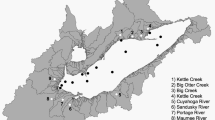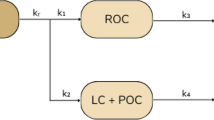Abstract
Plant pigment decay constants were determined for four macrophytes collected from the Hudson Estuary.Typha angustifolia andScirpus fluviatilis were used as representatives of emergent aquatic vegetation (EAV), andPotamogeton sp. andVallisneria americana were used to represent submerged aquatic vegetation (SAV). Litter bags were maintained in an environmental chamber in the dark for 104 d. The fastest rate of total mass loss was in the SAVV. americana and slowest in the EAVT. angustifolia. Changes in carotenoid and chloropigment concentration resulting from microbial and meiofaunal heterotrophy in each of the macrophytes were quantified using reverse-phase, high-performance liquid chromatography (RP-HPLC) techniques. Chlorophyllc and the carotenoid, fucoxanthin, provided useful biomarkers in determining the presence of epiphytic diatom growth, which only occurred on the SAV. The highest concentrations of phaeophorbidea, commonly used as an indication of metazoan grazing, were found in the SAVV. americana. Low concentrations of phaeophorbidea in the SAVPotamogeton sp. indicate inefficient use of this SAV by meiofaunal grazers. Lutein decayed slower than all other carotenoids in both EAV and SAV. Microcosm studies such as this are necessary to further understand the mechanisms and kinetics of photosynthetic pigment transformations in natural systems.
Similar content being viewed by others
Literature Cited
Barrett, J. andS. W. Jeffrey. 1971. A note on the occurrence of chlorophyllase in marine algae:Journal of Experimental Marine Biology and Ecology 7:255–262.
Bianchi, T. S. andS. Findlay. 1990. Plant pigments as tracers of emergent and submergent macrophytes from the Hudson River.Canadian Journal of Fisheries and Aquatic Sciences 47: 492–494.
Bianchi, T. S., R. Dawson, andP. Sawangwong. 1988. The effects of macrobenthic deposit-feeding on the degradation of chloropigments in sandy sediments.Journal of Experimental Marine Biology and Ecology 122:243–255.
Bidigare, R. R., T. J. Frank, C Zastrow, andJ. M. Brooks. 1986. The distribution of algal chlorophylls and their degradation products in the Souther Ocean.Deep-Sea Research 33:923–937.
Bidigare, R. R., J. H. Morrow, andD. A. Kiefer. 1989. Derivative analysis of spectral absorption by photosynthetic pigments in the western Sargasso Sea.Journal Marine Research 47:323–341.
Bidigare, R. R., R. C. Smith, K. S. Baker, andJ. Marra. 1987. Oceanic primary production estimates from measurements of spectral irradiance and pigment concentrations.Global Biogeochemical Cycles 1:171–186.
Boyd, C. E. 1970. Production, mineral accumulation and pigment concentrations inTypha latifolia andScirpus americanus.Ecology 51:285–290.
Braumann, T. andL. H. Grimme. 1981. Reversed-phase high performance liquid chromatography of chlorophylls and carotenoids.Biochimica Biophysica Acta 637:8–17.
Brinson, M. M., A. E. Lugo andS. Brown. 1981. Primary productivity, decomposition, and consumer activity in freshwater wetlands.Annual Review Ecology and Systematics 12:123–161.
Carpenter, S. R. andA. M. Bergquist. 1985. Experimental tests of grazing indicators based on chlorophylla degradation products.Archiv für Hydrobiologie 102:303–317.
Carpenter, S. R., P. R. Leavitt, J. J. Elser, andM. M. Elser. 1988. Chlorophyll budgets: response to food web manipulation.Biogeochemistry 6:79–90.
Cole, J. J., N. F. Caraco, and B. Peierls, In press, Phytoplankton primary production in the tidal, freshwater Hudson River, New York (USA).Verhandlungen der international Vereinigung fur theoretische und angewandte Limnologie.
Daley, R. J. 1973. Experimental characterization of lacustrine chlorophyll diagenesis. II. Bacterial, viral and herbivore grazing effects.Archiv für Hydrobiologie 72:409–439.
Davies, B. H. 1976. Carotenoids, p. 38–165.In T. W. Goodwin (ed.), Chemistry and Biochemistry of Plant Pigments. Academic Press, New York.
Furlong, E. T. andR. Carpenter. 1988. Pigment preservation and remineralization in oxic coastal marine sediments.Geochimica Cosmochimica Acta 52:87–99.
Gladden, J. B., F. R. Cantelmo, J. M. Croom, andR. Shapot. 1988. Evaluation of the Hudson River ecosystem in relation to the dynamics of fish populations.American Fisheries Society Monographs 4:37–52.
Hallegraeff, G. M. 1981. Seasonal study of phytoplankton pigments and species at a coastal station off Sydney: Importance of diatoms and nanoplankton.Marine Biology 61:107–118.
Hallegraeff, G. M. andS. W. Jeffrey. 1985. Description of new chlorophylla alteration products in marine phytoplankton.Deep-Sea Research 32:697–705.
Harrison, P. G. 1982. Control of microbial growth and of amphipod grazing by water-soluble compounds from leaves ofZostera marina.Marine Biology 67:225–230.
Harrison, P. G. andK. H. Mann. 1975. Detritus formation from eelgrass (Zostera marina): The relative effects of fragmentation, leaching and decay.Limnology and Oceanography 20:924–934.
Hawkins, A. J. S., B. L. Bayne, R. F. C. Mantoura, C. A. Liewellyn, andE. Navarro. 1986. Chlorophyll degradation and adsorption throughout the digestive system of the blue musselMytilus edulis.Journal of Experimental Marine Biology and Ecology 96:213–223.
Healey, F. P., J. Coombs, andB. E. Volcani. 1967. Changes in pigment content of the diatomNavicula pelliclosa (Breb) Hilse in silicon-starvation synchrony.Archiv für Mikrobiologie 59:131–142.
Hynninen, P. H. 1973. Chlorophylls. 3. Keto-enol tautomerism of chlorophylla andb—the nature of chlorophylla′ andb′.Acta Chemica Scandinavica 27:1487–1495.
Jeffrey, S. W. 1974. Profiles of photosynthetic pigments in the ocean using thin-layer chromatography.Marine Biology 26:101–110.
Jeffrey, S. W. andG. M. Hallegraeff. 1987. Chlorophyllase distribution in ten classes of phytoplankton: A problem for chlorophyll analysis.Marine Ecology Progress Series 35:293–304.
Kerfoot, W. C. 1988. Role of endogenous (chemical) defenses in plant herbivore interactions. Proceedings of the 22nd Meeting of Aquatic Plant Control Research Program, WES, Miscellaneous paper (A-88-5):31–47.
Kerfoot, W. C. 1989. Glucosinates and phenolics in aquatic macrophytes: Implications for studies and suggestions of practical uses for metabolic blocking agents. Proc. 23rd Meeting of Aquatic Plant Control Research Program, WES, Miscellaneous paper (A-89-1):178–189.
Klein, B. 1988. Variations of pigment content in two benthic diatoms during growth in batch cultures.Journal of Experimental Marine Biology and Ecology 115:237–248.
Klein, B. andA. Sournia. 1987. A daily study of the diatom spring bloom at Roscoff (France) in 1985. II. Phytoplankton pigment composition studied by HPLC analysis.Marine Ecology Progress Series 37:265–275.
Klein, B., W. W. C. Gieskes, andG. W. Kraay. 1986. Digestion of chlorophylls and carotenoids by the marine protozoanOxyrrhis marina studied by h.p.l.c. analysis of algal pigments.Journal of Plankton Research 8:827–836.
Kleppel, G. S. andR. E. Pieper 1984. Phytoplankton pigments in the gut contents of planktonic copepods from coastal waters off southern California.Marine Biology 78:193–198.
Leavitt, P. R. andS. R. Brown. 1988. Effects of grazing byDaphnia on algal carotenoids: Implications for paleolimnology.Journal of Paleolimnology 1:201–214.
Leavitt, P. R. and S. R. Carpenter. In press. Aphotic pigment degradation in the hypolimnion: Implications for sedimentation studies and paleoliminology.Limnology and Oceanography.
Liaaen-Jensen, S. 1985. Carotenoids of lower plants—Recent progress.Pure and Applied Chemistry 57:649–658.
Louda, W. J. andE. W. Baker. 1986. The biogeochemistry of chlorophyll, p. 107–126.In M. Sohn (ed.) Organic Marine Geochemistry. American Chemical Society, Washington, D.C.
Mann, K. H. 1982. Ecology of Coastal Waters. University of California. Berkeley, California. 322 p.
Mantoura, R. F. C. andC. A. Llewellyn. 1983. The rapid determination of algal chlorophyll and carotenoid pigments and their breakdown products in natural waters by reversephase high-performance liquid chromatography.Analytica Chimica Acta 151:297–314.
Plante, R., M. Plante-Cuny andJ. Reys. 1986. Photosynthetic pigments of sandy sediments on the north Mediterranean coast: Their spatial distribution and its effect on sampling strategies.Marine Ecology Progress Series 34:133–141.
Repeta, D. J. 1989. Early diagenesis of carotenoids in recent marine sediments—II. Degradation of fucoxanthin to loliolides.Geochimica Cosmochimica Acta. 53:699–707.
Repeta, D. J. andR. B. Gagosian. 1982. Carotenoid transformations in coastal marine waters.Nature 295:51–54.
Kepeta, D. J. andR. B. Gagosian. 1987. Carotenoid diagenesis in recent marine sediments—I. The Peru continental shelf (15 S, 75 W).Geochimica Cosmochimica Acta 51:1001–1009.
Rice, D. L. andK. R. Tenore. 1981. Dynamics of carbon and nitrogen during the decomposition of detritus derived from estuarine macrophytes.Estuarine and Coastal Shelf Sciences 13: 681–690.
Ridout, P. S. andR. J. Morris. 1988. Further studies of short-term variations in the pigment composition of a spring phytoplankton bloom.Marine Biology 97:597–602.
Ridout, P. S., P. J. Tibbetts andR. J. Morris. 1984. Novel carotenoid pigments in organic rich sediments from the Peru continental shelf.Oceanologica Acta 7:363–367.
Rioux-Gobin, C., C. A. Llewellyn andB. Klein. 1987. Microphytobenthos from two subtidal sediments from North Brittany. II. Variations of pigment compositions and concentrations determined by HPLC and conventional techniques.Marine Ecology Progress Series 40:275–283.
Sanger, J. E. andE. Gorham. 1970. The diversity of pigments in lake sediments and its ecological significance.Limnology and Oceanography 15:59–69.
Shuman, F. R. andC. J. Lorenzen. 1975. Quantitative degradation of chlorophyll by a marine herbivore.Limnology and Oceanography 20:580–586.
Smith, R. C., R. R. Bidigare, B. B. Prezelin, K. S. Baker, andJ. M. Brooks. 1987. Optical characterization of primary productivity across a coastal front.Marine Biology 96:575–591.
Sokal, R. S. andF. J. Rohlf. 1981. Biometry. W. H. Freeman and Company, San Francisco. 859 p.
SooHoo, J. B. andD. A. Kiefer. 1982a. Vertical distribution of phaeopigments. A simple grazing and photooxidative scheme for small particles.Deep-Sea Research 29:1539–1551.
SooHoo, J. B. andD. A. Kiefer. 1982b. Rates of production and kinetics of photooxidation.Deep-Sea Research 29:1553–1563.
Valiela, I., L. Koumjian, T. Swain, J. M. Teal, andJ. E. Hobbie. 1979. Cinnamic acid inhibition of detritus feeding.Nature 280:55–57.
Vernet, M., andC. J. Lorenzen. 1987. The presence of chlorophyllb and the estimation of phaeopigments in marine phytoplankton.Journal of Plankton Research 9:255–265.
Vernon, L. P. andG. R. Seely. 1966. The chlorophylls. Academic Press, New York. 679 p.
Watts, C. D., J. R. Maxwell, andL. Kjosen. 1977. The potential of carotenoids as environmental indicators, p. 391–413.In R. Campos and J. Goni (eds.) Advances in Organic Geochemistry. Pergamon Press, New York.
Webster, J. R. andE. f. Benfield. 1986. Vascular plant break-down in freshwater ecosystems.Annual Review of Ecology and Systematics 17:567–594.
Welschmeyer, N. A. andC. J. Lorenzen. 1985. Chlorophyll budgets: Zooplankton grazing and plytoplankton growth in a temperate fjord and the Central Pacific Gyres.Limnology and Oceanography 30:1–21.
Wood, M. A. 1979. Chlorophylla∶b ratios in marine planktonic algae.Journal of Phycology 15:330–332.
Wright, S. W. andS. W. Jeffrey 1987. Fucoxathin pigment markers of marine phytoplankton analysed by HPLC and HPTLC.Marine Ecology Progress Series 38:259–266.
Author information
Authors and Affiliations
Rights and permissions
About this article
Cite this article
Bianchi, T.S., Findlay, S. Decomposition of Hudson estuary macrophytes: Photosynthetic pigment transformations and decay constants. Estuaries 14, 65–73 (1991). https://doi.org/10.2307/1351983
Received:
Accepted:
Issue Date:
DOI: https://doi.org/10.2307/1351983




